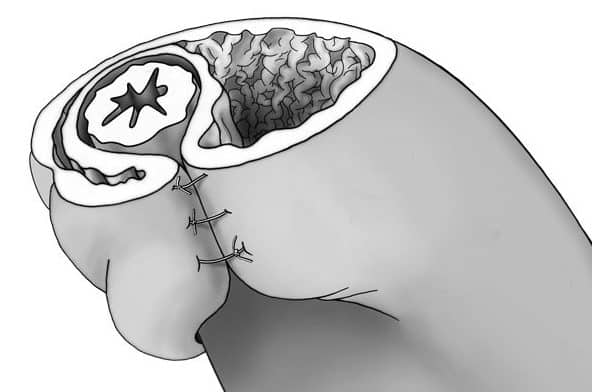This article is for educational purposes only. It should not be used as a template for consenting patients. The person obtaining consent should have clear knowledge of the procedure and the potential risks and complications. Always refer to your local or national guidelines, and the applicable and appropriate law in your jurisdiction governing patient consent.
Overview of Procedure
Laparoscopic Nissen fundoplication is a widely accepted approach for the surgical management of Gastro-oesophageal reflux disease (GORD) .
For the procedure, the gastric fundus is wrapped around the lower end of the oesophagus and sutured in place. For a Nissen fundoplication, a full 360 degree wrap is performed (Fig. 1).
Prior to undergoing surgery, patients should have pre-operative work-up with oesophagogastroduodenoscopy (OGD), 24 hour pH testing and/or oesophageal manometry studies. Anti-reflux surgery should not be offered to morbidly obese patients (BMI >35kg/m2) due to the high rate of failure.
Complications
Intra-Operative
| Complication | Description of Complication | Potential Ways to Reduce Risk |
| Haemorrhage | In laparoscopic surgery, port insertion can damage any intra-abdominal organ, including the abdominal aorta. | |
| Injury to surrounding structures including oesophagus, stomach, bowel, liver, and spleen | All nearly organs can be inadvertently damaged during the procedure. Of note, injury to the liver may occur as a result of the liver retraction required intra-operatively | |
| Conversion to open surgery including full laparotomy* | This may be necessary if the procedure is difficult. | |
| Drain insertion | In the presence of a large hiatus hernia, a thoracic drain should be placed through the defect to prevent fluid accumulation in the mediastinum | |
| Anaesthetic Risks | Includes damage to the teeth, throat and larynx, reaction to medications, nausea and vomiting, cardiovascular and respiratory complications | Forms a part of the anaesthetist assessment before the operation |
*This is not a true complication, merely a consequence of difficult pathology, but always should be included
Early
| Complication | Description of Complication | Potential Ways to Reduce Risk |
| Pain | The patient will have local anaesthesia into the wounds and simple analgesia post operatively | |
| Abdominal fullness, dysphagia, postprandial discomfort | Symptoms related to oedema at the site of the fundoplication | Patients are advised to have a liquid or blended diet for around 3 weeks post-operatively |
| Infection | Superficial wound infection is possible, however collections in the pelvis or paracolic gutters can also occur. | Peri-operative antibiotics will reduce the risk of wound infections |
| Scarring | Any scar may form a keloid scar, particular in high-risk ethnicities. | |
| Pneumothorax or surgical emphysema | A pneumothorax may occur following excessive hiatal dissection and a pneumomediastinum can occur as a result of intra-peritoneal gas pressures | |
| Oesophageal or gastric perforation | Damage during the dissection or repair can lead to viscus perforation | |
| Blood Clots | DVTs and PEs are a possibility in any operation. The risk is increased in patients with a raised BMI, on the pill, recent flights, previous DVT, pregnancy, smokers, cancer and prolonged bed rest | The patient will be given anti-embolism stocking and low molecular weight heparin peri-operatively to minimise this risk as deemed appropriate |
| Stroke, MI, Kidney Failure, Death | Although small, this is always a risk in any major surgery |
Late
| Complication | Description of Complication | Potential Ways to Reduce Risk |
| Bloating/ difficulty belching | Inability to belch as a result of the fundoplication can lead to significant abdominal bloating and discomfort | Avoid carbonated drinks |
| Dysphagia | May result from wrap migration or the wrap being too tight | |
| Hernia | Any incision through the abdominal wall has the potential to cause a hernia in future, either through a port site or in open surgery. | Avoid strenuous lifting for around 6 weeks post-operatively |
| Adhesions | Abdominal surgery may cause adhesions as a reaction to the procedure. | |
| Failure and re-do surgery | If symptoms recur or are severe, patients may require re-do surgery to modify the wrap |

